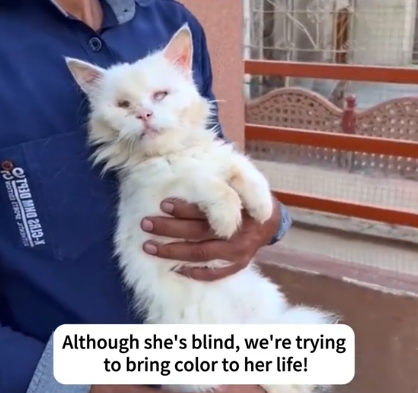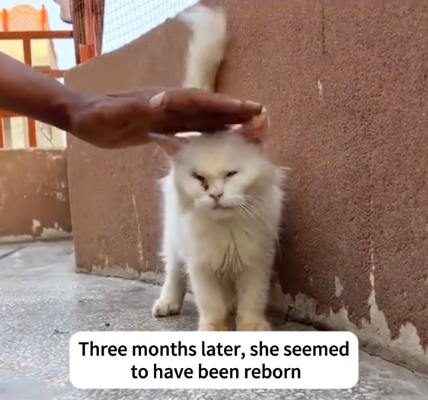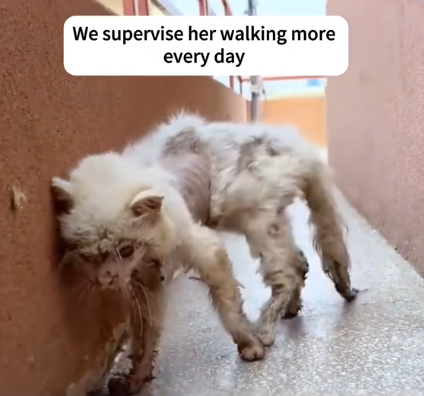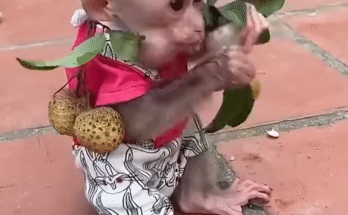
I first saw her on a rainy afternoon as I drove home from work. The clouds hung low, and the streets shimmered with puddles. I almost missed her—just a frail, shivering figure crouched behind an overflowing trash bin near the alleyway. Something compelled me to slow down, then stop altogether. I rolled down my window and looked more closely.
She was a dog—but barely recognizable as one. Her body was frighteningly thin, each rib poking out against her skin as though begging for mercy. Her fur, once probably thick and beautiful, had almost entirely fallen off from her face. The bare, raw skin beneath was pinkish, inflamed, and spotted with scabs. Her eyes, though, were what caught me—dark, weary, but still holding a faint glimmer of life.
I parked and approached slowly, not wanting to scare her. Her head lifted slightly, but she didn’t run. She was too weak. I knelt a few feet away and spoke softly.
“Hey, girl… you okay? You look like you’ve been through a war.”
She blinked slowly, unsure if I was friend or foe. I reached into my bag and took out my leftover lunch—a piece of chicken and some rice. I placed it on the ground and stepped back. She sniffed it cautiously, then devoured it in seconds.
That was the beginning
Over the next three days, I returned to the same spot with food and water. She started recognizing my scent, even wagged her tail—just a tiny twitch—when she saw me coming. On the fourth day, I brought a blanket and gently wrapped her in it. She didn’t resist. I took her home.
My apartment wasn’t prepared for a rescue dog in such poor shape, but I did what I could. I laid out towels, prepared soft food, and set up a quiet corner for her to rest. I named her Willow—because, like a willow tree, she had bent but hadn’t broken.
The first visit to the vet was heartbreaking. Mange. Severe malnutrition. Infections in both ears. Overgrown nails. The vet guessed she had been abandoned months ago and somehow survived on the streets, scavenging and hiding. She was probably no older than four, though her condition made her seem ancient.
The treatment plan was intense—medicated baths, antibiotics, high-nutrition meals, rest. I committed to it fully. She deserved that and more.

Every day became a small victory. Willow began eating with more enthusiasm. She no longer flinched when I reached out to touch her. She even started exploring the apartment, tail swishing ever so slightly behind her. Her fur, at first patchy and sparse, slowly began to grow back, soft and pale around the edges of her face.
There were hard days too. Some mornings she refused to eat. Sometimes she whimpered in her sleep, legs twitching as if fleeing from nightmares only she knew. But I stayed by her side, whispering comfort, letting her know she was safe now.
Friends who visited were shocked by her transformation over the months.
“This is the same dog you found by the trash?” my friend Nina asked, stunned.
“Same one,” I said proudly. “She’s a fighter.”
And Willow was. By the third month, she could trot during our walks. She barked—timidly at first—when someone knocked on the door. The fur on her face had returned in soft tufts, framing her bright, intelligent eyes. Her ribs no longer showed. She had even begun to play with a squeaky toy I’d bought her—a sign she was not just surviving, but living.
One particularly sunny morning, we went to the park. It was the first time I’d let her off the leash in a secure area. She hesitated at first, looking back at me. I nodded and smiled.
“Go on, girl. Run.”
And she did.
Willow ran like the wind, ears flying back, paws kicking up little clouds of dust. She was free. The sight brought tears to my eyes. Months ago, she was too weak to stand. Now she was leaping through the grass like the world belonged to her.
People noticed her. A little girl came over to pet her, and Willow licked her hand. The girl’s mother asked what breed she was, and I found myself telling Willow’s story.
“She was very skinny and had lost all the fur on her face,” I began. “I found her by the garbage bins in the rain.”
The mother’s eyes welled up. “And look at her now. She’s beautiful.”
“She always was,” I replied. “She just needed someone to see it.”

Willow’s story spread further than I expected. I posted her before-and-after photos on social media. They went viral. People from around the world commented with support, love, and their own rescue stories. One message, in particular, stayed with me:
“Thank you for giving her a second chance. You didn’t just save her—you reminded us all what love can do.”
A year passed. Willow was unrecognizable from the creature I’d first met—her coat was thick and shiny, her posture proud, her eyes always full of curiosity. We had grown together. Her resilience taught me patience. Her trust, after so much betrayal, taught me the depth of forgiveness.
Sometimes I wonder about her past. Who abandoned her? How did she survive for so long? I’ll never know. But maybe I don’t need to. What matters is who she is now—a loyal, loving dog with a heart stronger than most humans I know.
She sleeps beside my bed every night, sometimes resting her chin on my feet. In those quiet moments, I remember how far she’s come.
She was very skinny and had lost all the fur on her face.
Now, she’s everything soft, strong, and whole. She’s Willow—the dog who refused to give up. And I’m endlessly grateful that I stopped that day in the rain.


